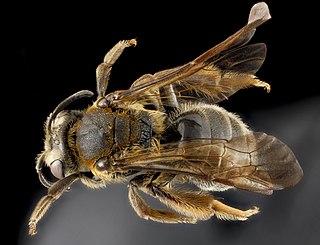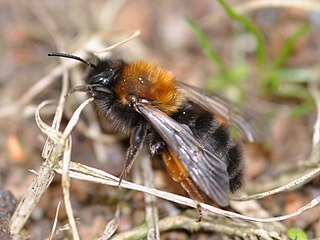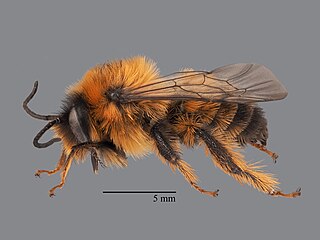
Mason bee is a name now commonly used for species of bees in the genus Osmia, of the family Megachilidae. Mason bees are named for their habit of using mud or other "masonry" products in constructing their nests, which are made in naturally occurring gaps such as between cracks in stones or other small dark cavities. When available, some species preferentially use hollow stems or holes in wood made by wood-boring insects.

The Andrenidae are a large, nearly cosmopolitan family of solitary, ground-nesting bees. Most of the family's diversity is located in temperate or arid areas. It includes some enormous genera. One of the subfamilies, Oxaeinae, is so different in appearance that they were typically accorded family status, but careful phylogenetic analysis reveals them to be an offshoot within the Andrenidae, very close to the Andreninae.

Andrena is a genus of bees in the family Andrenidae. With over 1,500 species, it is one of the largest genera of animals. It is a strongly monophyletic group that is difficult to split into more manageable divisions; currently, Andrena is organized into 104 subgenera. It is nearly worldwide in distribution, with the notable exceptions of Oceania and South America. Bees in this genus are commonly known as mining bees due to their ground-nesting lifestyle.

Osmia bicornis is a species of mason bee, and is known as the red mason bee due to its covering of dense gingery hair. It is a solitary bee that nests in holes or stems and is polylectic, meaning it forages pollen from various different flowering plants. These bees can be seen aggregating together and nests in preexisting hollows, choosing not to excavate their own. These bees are not aggressive; they will only sting if handled very roughly and are safe to be closely observed by children. Females only mate once, usually with closely related males. Further, females can determine the sex ratio of their offspring based on their body size, where larger females will invest more in diploid females eggs than small bees. These bees also have trichromatic colour vision and are important pollinators in agriculture.

Andrena agilissima is a species of mining bee. They are present in most of Europe, the Near East and North Africa and can be found from April through July. Andrena agilissima is an oligolectic species, feeding only on the pollen of a few genera of Cruciferous vegetables.

Andrena hattorfiana is a species of mining bees belonging to the family Andrenidae subfamily Andreninae.

Andrena antoinei is an extinct species of mining bee in the family Andrenidae described from a single fossil found in a Late Oligocene lake in present-day France that existed in semi-arid conditions.

Dasypoda hirtipes, the pantaloon bee or hairy-legged mining bee is a species of solitary mining bee from the family Melittidae. It is a widespread bee which is found from Great Britain to China.

Andrena scotica, the chocolate mining bee or hawthorn bee, is a species of mining bee from the family Andrenidae. It occurs in western Europe and is one of the most frequently encountered mining bees found in Great Britain, where it had been previously misidentified as Andrena carantonica.

Andrena trimmerana, Trimmer's mining bee, is a species of mining bee from the family Andrenidae. It occurs in the western Palearctic but its true status in some areas is muddled due to issues of taxonomy and misidentification.

Andrena vaga, the grey-backed mining bee, is a species of solitary bee which is found in most of Europe but which is very rare in Great Britain, where it may be recolonizing in the south-east after previously being extirpated. It specialises in feeding on the pollen of willows.

The Appalachian miner bee is a species of miner bee in the family Andrenidae. Another common name for this species is Alleghany andrena. It is found in North America. Its nests typically only have one or two cells. Adults overwinter in soil.

The Clark's miner bee is a species of miner bee in the family Andrenidae. Other common names include Clark's andrena and Clarke's mining bee. It is found in Europe and Northern Asia and North America.

Andrena prunorum, otherwise known as the purple miner bee, is a species of solitary bees in the family Andrenidae. It is commonly found in the continental United States as well as much of North and Central America. Andrena prunorum is a spring-flying, ground-nesting bee that serves as a ubiquitous generalist in ecological settings. Both males and females live as prepupae in the winter in which they mate, and the females seek new sites for ground burrows. From there, they construct small cells surrounding a ball of pollen combined with nectar to nourish a laid egg before each cell is sealed, and the cycle begins anew. A. prunorum generally prefer the pollen derived from Rosaceae plants but will pollinate fruit trees if given the opportunity.

Andrena helvola , the coppice mining bee, is a Palearctic species of mining bee from the genus Andrena.
The Porter's miner bee is a species of miner bee in the family Andrenidae. It is found in North America. It was first described by Theodore Dru Alison Cockerell in 1900 and named after the collector of the type specimen Wilmatte Porter.
Andrena albifacies is a species of mining bee in the genus Andrena of the family Andrenidae and the order Hymenoptera. This species plays a crucial role in pollination.

Dasypoda delectabilis, the delightful pantaloon bee, is a species of solitary bee from the family Melittidae. It was described in 2023 based on a single male specimen caught in arid areas of south-eastern Iran.

Dasypoda radchenkoi, also known as Radchenko's pantaloon bee, is a species of solitary bee from the family Melittidae. It was described in 2023 in the scientific journal Osmia based on specimens caught in the limestone areas of southern Spain.














